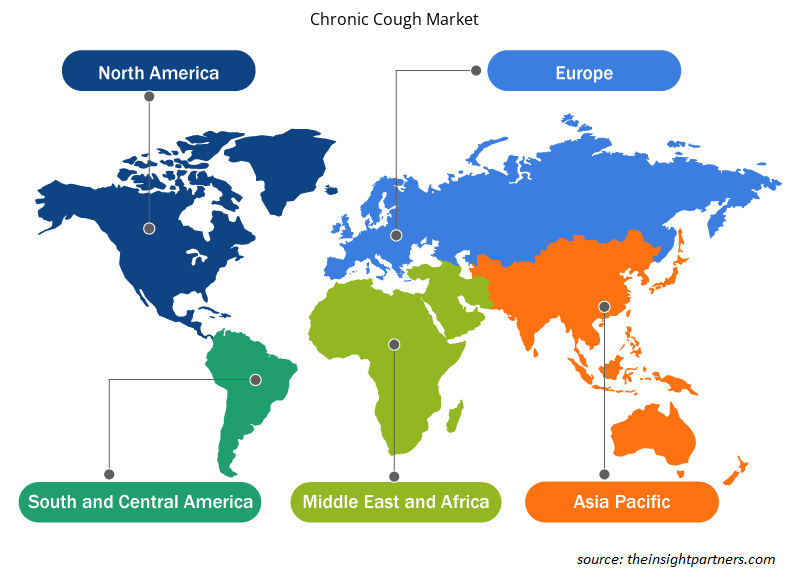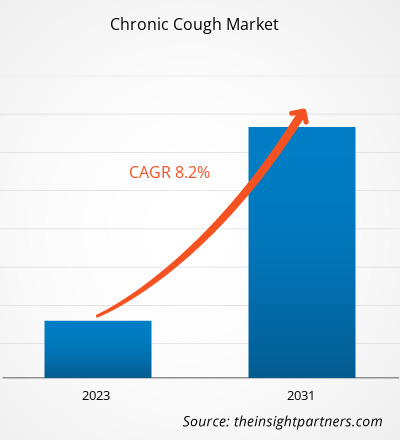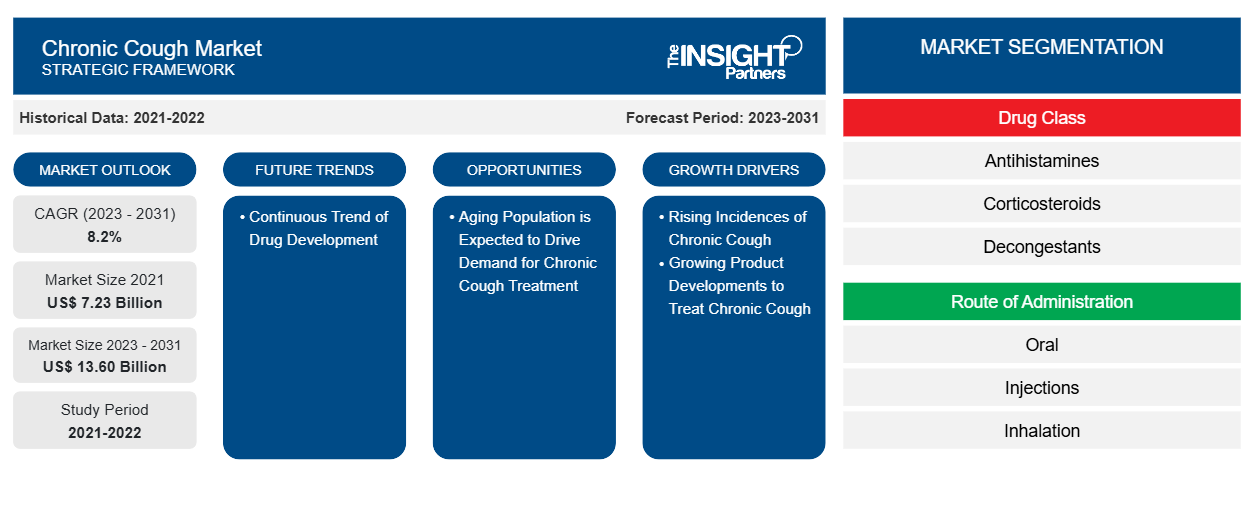2021 年慢性咳嗽市场规模为 72.3 亿美元,预计到 2031 年将从 2023 年的 XX 亿美元增至 136 亿美元。预计 2023-2031 年市场复合年增长率为 8.2%。人们对呼吸系统问题的认识不断提高,医学研究和治疗选择的进步,以及药物开发的持续趋势,可能仍是慢性咳嗽市场的主要趋势。
慢性咳嗽市场分析
全球慢性咳嗽市场主要受慢性肺部感染疾病患病率上升的推动,因为持续咳嗽是一种普遍的症状,以及治疗慢性咳嗽的新产品的开发。市场扩张的推动因素是人们越来越重视呼吸健康和保健,以及政府和非政府举措。
慢性咳嗽市场概况
慢性咳嗽会持续八周或更长时间。感染、哮喘和胃反流病都会导致慢性咳嗽。慢性咳嗽的症状和体征包括喉咙后部有液体流出的感觉(鼻后滴漏)和头痛等。经常清嗓、喉咙痛、声音嘶哑、呼吸急促、喘息、口腔有酸味或胃灼热。医疗基础设施、诊断设施和患者教育计划的投资有所增加,以改善慢性咳嗽的管理和早期发现。
定制此报告以满足您的需求
您可以免费定制任何报告,包括本报告的部分内容、国家级分析、Excel 数据包,以及为初创企业和大学提供优惠和折扣
-
获取此报告的关键市场趋势。这个免费样品将包括数据分析,从市场趋势到估计和预测。
慢性咳嗽市场驱动因素和机遇
慢性咳嗽治疗的普及有利于市场增长
感染、肺部疾病和支气管炎等疾病也可能导致慢性咳嗽。哮喘等疾病在全球范围内呈上升趋势;它在儿童和成人中很常见。根据 2024 年 2 月发表的一项题为“阻塞性肺病负担 (BOLD) 研究中慢性咳嗽的患病率、其风险因素和人群归因风险:一项跨国横断面研究”的研究,慢性咳嗽的患病率为 2% 至 18%。吸烟、哮喘、慢性阻塞性肺病 (COPD)、肥胖、上呼吸道咳嗽综合征 (UACS) 和胃食管反流病 (GORD) 是与慢性咳嗽最常相关的一些因素。COPD), obesity, upper airway cough syndrome (UACS), and gastro-oesophageal reflux disease (GORD) are some of the factors that have most commonly been associated with chronic cough.
人口老龄化预计将推动慢性咳嗽治疗市场的需求
老年人更容易患慢性咳嗽,而年龄增长是免疫力下降的主要因素。由于年龄因素,器官和健康组织的退化会引发多种健康状况。慢性咳嗽是老年人中常见的健康状况之一。随着年龄的增长,呼吸系统开始退化。因此,老年人患肺炎和流感等呼吸道感染的几率增加。
随着发达国家和发展中国家的死亡率下降,全球老龄人口正在增长。医疗行业的发展提高了公共卫生水平,从而延长了预期寿命。据世界卫生组织称,到 2050 年,世界 60 岁及以上人口将达到 21 亿。预计 2020 年至 2050 年间 80 岁或以上人口的数量将增加两倍,达到 4.26 亿。因此,预计在预测期内,不断增长的老年人口可能会需要更多的慢性咳嗽治疗。
慢性咳嗽市场报告细分分析
有助于得出慢性咳嗽市场分析的关键部分是药物类别、给药途径和分销渠道。
- 根据药物类别,慢性咳嗽市场细分为抗组胺药、皮质类固醇、减充血剂、复方药物、抗生素、酸阻滞剂和其他药物类别。复方药物在 2023 年占据了更大的市场份额。
- 根据给药途径,市场分为口服、注射、吸入、其他给药途径。口服部分在 2023 年占据了较大的市场份额。
- 就分销渠道而言,市场分为医院药房、网上药房和零售药房。2023 年,医院药房占据了市场主导地位。
慢性咳嗽市场份额按地区分析
慢性咳嗽市场报告的地理范围主要分为五个地区:北美、亚太、欧洲、中东和非洲、南美和中美。
北美一直主导着慢性咳嗽市场。非处方 (OTC) 产品需求的不断增长是预计在报告期内推动该地区收入增长的主要因素。此外,慢性咳嗽病例的增加、老年人口的迅速增长、车辆污染的增加以及对先进药物的认识不断提高,都是推动咳嗽治疗产品需求的其他一些因素。
慢性咳嗽市场区域洞察
Insight Partners 的分析师已详细解释了预测期内影响慢性咳嗽市场的区域趋势和因素。本节还讨论了北美、欧洲、亚太地区、中东和非洲以及南美和中美洲的慢性咳嗽市场细分和地理位置。

- 获取慢性咳嗽市场的区域特定数据
慢性咳嗽市场报告范围
| 报告属性 | 细节 |
|---|---|
| 2021 年市场规模 | 72.3亿美元 |
| 2031 年市场规模 | 136亿美元 |
| 全球复合年增长率(2023 - 2031) | 8.2% |
| 史料 | 2021-2022 |
| 预测期 | 2023-2031 |
| 涵盖的领域 |
按药物类别
|
| 覆盖地区和国家 |
北美
|
| 市场领导者和主要公司简介 |
|
慢性咳嗽市场参与者密度:了解其对业务动态的影响
慢性咳嗽市场正在快速增长,这得益于终端用户需求的不断增长,而这些需求又源于消费者偏好的不断变化、技术进步以及对产品优势的认识不断提高等因素。随着需求的增加,企业正在扩大其产品范围,进行创新以满足消费者的需求,并利用新兴趋势,从而进一步推动市场增长。
市场参与者密度是指在特定市场或行业内运营的企业或公司的分布情况。它表明在给定市场空间中,相对于其规模或总市场价值,有多少竞争对手(市场参与者)存在。
在慢性咳嗽市场运营的主要公司有:
- 诺华公司
- 梯瓦制药工业有限公司
- 葛兰素史克公司
- 拜耳公司
- 迈兰公司
- Amneal 制药公司
免责声明:上面列出的公司没有按照任何特定顺序排列。

- 了解慢性咳嗽市场顶级关键参与者概况
慢性咳嗽市场新闻和最新发展
慢性咳嗽市场通过收集一级和二级研究后的定性和定量数据进行评估,其中包括重要的公司出版物、协会数据和数据库。以下是慢性咳嗽市场的发展列表:
- Trevi Therapeutics, Inc. 是一家临床阶段生物制药公司,正在开发试验性疗法 Haduvio(口服纳布啡缓释剂),用于治疗特发性肺纤维化 (IPF)、难治性慢性咳嗽 (RCC) 和结节性痒疹患者的慢性咳嗽,该公司宣布启动其 2b 期 CORAL 临床试验,在约 160 名患有慢性咳嗽的 IPF 患者中评估三种剂量的 Haduvio 与安慰剂的疗效。(来源:Trevi Therapeutics,新闻稿,2023 年)
- 加拿大临床阶段药物开发公司 Algernon Pharmaceuticals Inc. 欣然宣布,该公司已与美国私营药物开发公司 Seyltx Inc. 达成协议,收购 Algernon 的 NP-120(“艾芬地尔”)研究项目。(来源:Algernon Pharmaceuticals Inc.,新闻稿,2024 年)
慢性咳嗽市场报告覆盖范围和交付成果
“慢性咳嗽市场规模和预测(2021-2031)”报告对市场进行了详细分析,涵盖以下领域:
- 范围内所有主要细分市场的全球、区域和国家层面的市场规模和预测
- 市场动态,如驱动因素、限制因素和关键机遇
- 未来的主要趋势
- 详细的 PEST/波特五力分析和 SWOT 分析
- 全球和区域市场分析涵盖关键市场趋势、主要参与者、法规和最新市场发展
- 行业格局和竞争分析,涵盖市场集中度、热点图分析、知名参与者和最新发展
- 详细的公司简介
- 历史分析(2 年)、基准年、预测(7 年)及复合年增长率
- PEST和SWOT分析
- 市场规模、价值/数量 - 全球、区域、国家
- 行业和竞争格局
- Excel 数据集
近期报告
客户评价
购买理由
- 明智的决策
- 了解市场动态
- 竞争分析
- 客户洞察
- 市场预测
- 风险规避
- 战略规划
- 投资论证
- 识别新兴市场
- 优化营销策略
- 提升运营效率
- 顺应监管趋势























 获取免费样品 - 慢性咳嗽市场
获取免费样品 - 慢性咳嗽市场